
Article and all photos by Joe Mock, BaseballParks.com
All rights reserved
WICHITA, KANSAS It’s become a cliché in sports for a winning coach in any sport to talk about the incredible adversity his players had to overcome.
| Ballpark Stats |
 |
| Team: Wichita Wind Surge of the Double-A Central League |
| First game: May 11, 2021, a 3-2 loss to Amarillo |
| Capacity: 10,000 |
| Dimensions: LF – 340; LCF – 369; CF – 400; RCF – 360; RF – 325 |
| Architects: DLR Group, Designer and Baseball Specialist; SJCF Architecture, Architects of Record |
| Construction: JE Dunn and EBY |
| Price: $75 million |
| Home dugout: 3B side |
| Field points: Northeast |
| Playing surface: Latitude 36 Bermudagrass |
| Naming rights: not finalized when the stadium opened |
| Ticket info: www.milb.com/wichita/tickets/ |
| Betcha didn’t know: The new ballpark was built on the same site as the demolished Lawrence-Dumont Stadium. Today’s second base is about where home plate was in the old park. |
For one franchise, the adversity was more than any one organization should ever have to face. Yet the Wichita Wind Surge endured the soul-crushing challenges and, well, surged forward. It’s a compelling story.
First, the pandemic wiped out the 2020 Minor League season. True, this was the reality for every team in the affiliated Minors, but imagine the situation in Wichita. Not only did they have the expectation of playing in their brand-new ballpark, freshly built on the banks of the Arkansas River, they also faced a demotion from Triple-A to Double-A as part of MLB’s usurping the governance of the Minors. As far as I know, no money was wired to CBI Investors, which owns the team, to compensate them for the millions of dollars of lost franchise value.
But sadly, it gets worse. The heart and soul of the franchise was Lou Schwechheimer. When CBI acquired the Triple-A New Orleans Baby Cakes with the intent of moving them to Wichita, Schwechheimer was the face of the effort, going in front of the TV cameras, rallying the front-office employees, and leading the effort to gain corporate sponsors. He was the consummate salesman, whose endless energy and boundless positivity propelled the ballpark project forward. He was the one with the vision.
“Lou was always looking beyond the building of the ballpark. That’s what captivated the city. He got everyone on the same page,” says Tom Tingle, Senior Associate at architecture firm DLR Group. During the design-and-construction phase for the ballpark, “we met weekly. We would never leave those meetings without making decisions. Lou got everyone to reach consensus on every item.”
When it appeared the ballpark’s first game would be April 14, 2020, Schwechheimer emailed me often, telling me how happy he was that I would be there to cover the opener, and how he’d make time for me for an interview and a tour of the park. I still have those emails.
Our meeting never happened. Not only had COVID robbed fans of the 2020 Minor League season, it claimed Lou, who passed away from complications from the virus on July 29, 2020.
Suddenly, the guiding light of the franchise had been snuffed out. The adversity had escalated to a level that would break the backs of many teams, leaving them rudderless, with no one charting the path forward.
So don’t try to tell me that your basketball team “overcame adversity” because your leading scorer had a cold-shooting night.
The Wind Surge pulled together and opened the 2021 season in style in beautiful Riverfront Stadium. Jordan Kobritz, a partner in CBI and the team’s CEO, said overcoming the loss of Schwechheimer was possible due to “a combination of things. The core decision-making group consisted of three seasoned veterans — Lou, (General Partner) Matt White and myself. Matt was with Lou in Pawtucket for 25 years, and the three of us had been through the wars, and were by Lou’s side” through the planning and construction of the stadium.
“Lou was always the front person, and Matt and I were more than happy with that,” he continued. “When Lou passed, we picked up the pieces and moved forward. That’s not to say it was easy, (but) we knew we had a responsibility and we had a goal, and we would achieve it.”
| Lawrence-Dumont |
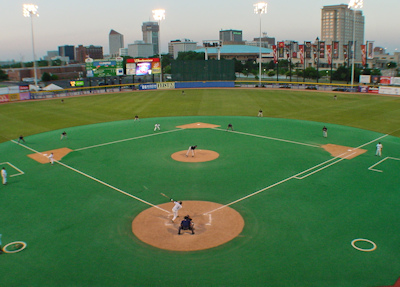 |
| The Wichita Wranglers played at Lawrence-Dumont Stadium until 2007, when they moved to Arkansas. The ballpark had a bizarre combination of Astroturf in the infield and natural grass in the outfield. |
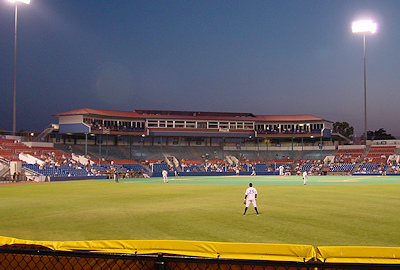 |
The team also had tremendous support from the business community and the fans of Wichita. Following the cancellation of the 2020 season and the uncertainty about whether games would be played in 2021, “90% of our sponsors and fans stuck by us and didn’t ask for a refund. The City stood behind us. Everyone involved got us to this Opening Day.”
The list of people within the organization who stepped up when Lou passed away is a long one, but a couple deserve special mention. One was Lou’s widow Jane, who filled the Majority General Partner role and today sits at what was Lou’s desk. The two met in 1986 when Jane was an intern with the Pawtucket Red Sox, where Lou was the GM. They married in 1991. Their daughter Jenn is also in the Wind Surge’s front office. The family’s foundation is committed to helping underprivileged children in the community, something that mattered a great deal to Lou.
Also there was longtime front-office veteran Jay Miller, who’d been an exec with New Orleans, Round Rock, the Texas Rangers and Sugarland.
So everyone was rowing in the same direction to carry out Lou’s vision.
Even the team’s nickname is part of his legacy. Kobritz explained that “wind is synonymous with Kansas, so it was a popular idea to include the word ‘wind’ in the name. In thinking about what we wanted Wichita to be, it was Lou’s idea to incorporate ‘surge.’ We want this city to go to the next level, to be on the move, to surge forward.”
He added that the leadership was in agreement not to have a “cutesy” nickname. “We think Wind Surge speaks volumes about Wichita.”
Next came conversations about the team colors. “They needed to fit in with Midwestern values, to be traditional and All American.” They decided on navy blue, red, sky blue and yellow gold – the gold being important because Wichita State is extremely popular here, and that’s their predominant color.
Those colors are quite visible at Riverfront Stadium … as is something else: art. All construction projects in Wichita require a certain percentage of the budget be devoted to art projects – murals, sculptures, paintings, you name it. And it is inescapable at the ballpark – even in the restrooms!
The only other ballpark I can think of with similar artfulness is T-Mobile Park in Seattle, with mobiles, sculptures and murals galore. The Marlins’ stadium has quite a bit, too.
So now that the Wind Surge has overcome incredible adversity, how did Riverfront Stadium turn out? Is it in the right place and is it the right size for this market? Read on!
The Setting
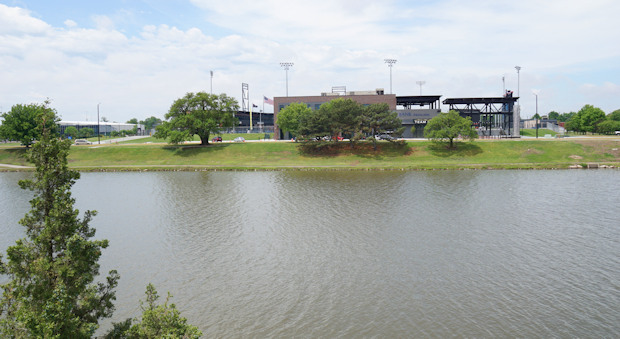
If you’ve not been to Wichita, but you have a preconceived notion of what the city is like, you’re no doubt wrong.
If you think it’s a backwards hick city with no culture, no dining and no major businesses, you couldn’t be more incorrect.
Wichita is the largest city in Kansas, with a population of almost 400,000, making it the 50th largest city in the U.S. It houses the corporate headquarters of Cessna Aircraft, Koch Industries, Spirit AeroSystems, Beechcraft, Excel Industries and Learjet. And did you know Pizza Hut started on the north side of the city (photo), and that the Freddy’s Frozen Custard chain’s home office is on Wichita’s east side?
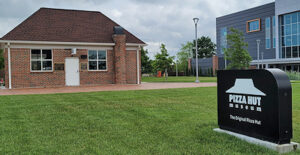 And where there are business headquarters, there’s potential for corporate sponsorships for a baseball team.
And where there are business headquarters, there’s potential for corporate sponsorships for a baseball team.
So why didn’t this large city have affiliated Minor League Baseball before now? Well, the Wichita Wranglers of the Double-A Texas League called the city’s Lawrence-Dumont Stadium home for 21 seasons, until 2007. The franchise was lured away to a brand-new ballpark in Northwest Arkansas, but an indy league team quickly jumped in to fill the void. In addition, the National Baseball Congress World Series drew tens of thousands of fans to the city every year from 1935 through 2018.
City leaders felt affiliated ball can and should be played here, but Lawrence-Dumont simply wasn’t going to cut it. So they created a bold plan to replace the aging ballpark – in the same riverfront spot – to attract a new team. And they weren’t just shooting for a Double-A franchise like they had before. They were after a Triple-A squad.
And in the New Orleans Baby Cakes, they were going to get one. It’s not the market’s fault it didn’t turn out that way. If there had been a 2020 season, the Wind Surge would’ve been in the Triple-A Pacific Coast League. Instead, following the cancellation of the season, MLB announced a complete reshuffling of the deck, moving franchises up and down the Minor League ladder, and tossing 42 teams out of affiliated ball altogether. At the end of the process, the Wind Surge had been knocked down a peg to Double-A.
This no doubt stung the locals in Wichita, since they rightly deserved to be a Triple-A market like Oklahoma City, Nashville and Indianapolis. Further, they’d spent $75 million building a ballpark to Triple-A standards. More on that later.
One reason this mattered to the city is its psychological make-up more than its demographics. “This is a baseball community and it’s a winning community,” Nick Bernabe, knowledgeable sales associate for the Wind Surge, told us. “At a lot of places, fans come out for a good time. Here, the fans come wanting a win.”
Regardless of the level of play, Riverfront Stadium was intended to be a catalyst of development on the west side of the Arkansas River, opposite downtown. This neighborhood is known as the Delano District. And there’s no reason that the development won’t happen.
Local firm SJCF Architecture served as the Architect of Record on the stadium’s design. “This project is near and dear to us because we understand how much it will complement the Delano District and produce economic development opportunities for Wichita that will be beneficial for years to come,” says the firm’s President Shannon Bohm. “We live here, we work here, we are invested in this community. Our firm started in Wichita 64 years ago and we are proud of each of our projects here. This stadium specifically, though, was designed to be distinctly Wichita.”
And that is a very good thing.
But before construction could begin on the new ballpark, Lawrence-Dumont had to be demolished … and that left some locals grumbling, because it’s where they’d been attending games for decades.
“A lot of residents were bemoaning the loss of Lawrence-Dumont,” Tingle recalls. “When it came time to demolish it, it literally fell down before we could implode it. It turns out that a lot of concrete that was supposed to have rebar in it didn’t. There could’ve been a tragedy at a game where crowded stands had collapsed. Luckily that hadn’t happened. Let’s just say that no one is crying over the loss of Lawrence-Dumont now.”
Without a doubt, the neighborhood surrounding the old ballpark had changed greatly over the decades. It was an area that needed a make-over – and it’s getting it.
First, the Delano District along Douglas Avenue now has beautiful shops, eateries and an art studio. This puts this just two blocks north of the new ballpark. Businesses here include Milkfloat, an adorable shop that features specialty coffees and pastries, and The Monarch, an industrial-chic restaurant with a unique menu and a huge bourbon selection.
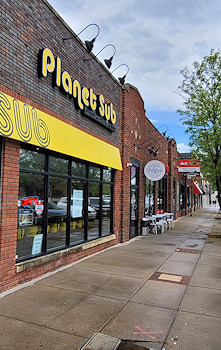  |
| Lovely storefronts and cute shops dot Douglas Avenue in the Delano District. Above is the interior of Milkfloat, which serves baked goodies and gourmet coffees. |
And this renaissance prompted a new hotel, Home 2 Suites, to open at the end of 2020 just north of Douglas, making it within walking distance of the ballpark. And across Sycamore Street from the hotel is a beautiful new public library. This area is really on the move, and the ballpark is fueling the momentum.
The commercial development that is yet to come is also quite amazing. Between the ballpark and the river will be a string of structures with eateries and other businesses. Another hotel is likely, as is a baseball museum designed by a team led by SJCF Architecture that will be within the ballpark. Additional residences like the recently opened 225 Sycamore will offer apartments and condos, permitting residents to live, eat and play all within the immediate area.
And linking all of this to the city’s downtown on the east side of the river will be a new pedestrian bridge, long envisioned by Lou Schwechheimer.
At the heart of this neighborhood, adjacent to the ballpark, will be a city-operated transportation hub with a new 500-space parking garage. While there is already plenty of parking on the downtown side of the river a short walk away from the stadium, these additional nearby spaces – plus the ability to ride a bus to a game – will help tremendously.
 Further, DLR Group Principal Bob Carlson says that the plan is for McLean Boulevard (see photo) – which runs parallel to the river on the ballpark side – to be closed to vehicle traffic when the Wind Surge is playing. “It will be an unticketed party zone,” he notes.
Further, DLR Group Principal Bob Carlson says that the plan is for McLean Boulevard (see photo) – which runs parallel to the river on the ballpark side – to be closed to vehicle traffic when the Wind Surge is playing. “It will be an unticketed party zone,” he notes.
Adds Carlson, “When you build a ballpark, you want the city to grow toward it, but you also want the ballpark to grow out toward the city.” That’s exactly what is happening here.
The space to do all of these things – restaurants, a hotel, a museum, shops, residences – was baked into the master plan for Riverfront Stadium. It’s nice now, and it will only get better.
“The unique history and character of the Delano neighborhood was a strong influence on the architectural design and expression of the Stadium,” adds Bohm. “Gathering places for the social activities of the community, from tailgating, food trucks, car shows, to other sports events (including football and soccer), chili cookoffs, fireworks, kids play areas and more were accounted for in the layout and design of the stadium. This universal functionality will allow the facility to adapt to changes in expectations and uses as time passes.”
The Exterior
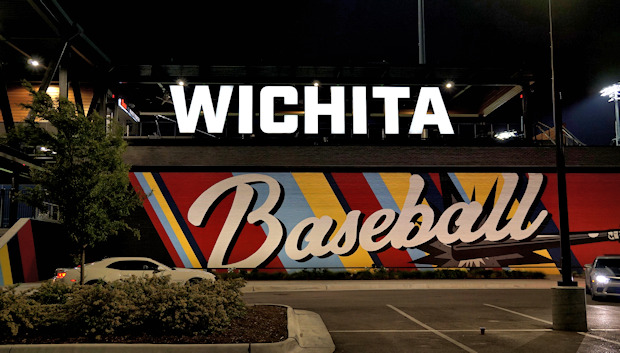
The idea that an impenetrable wall should surround a ballpark – keeping ticket-buyers in and non-ticket buyers from being able to see the field at all – went away years ago. It is certainly true of Riverfront Stadium, where iron fencing allows pedestrians to look into the lovely seating bowl – especially as people are strolling along the riverbank.
They’ll also want to stop and look at all of the art.
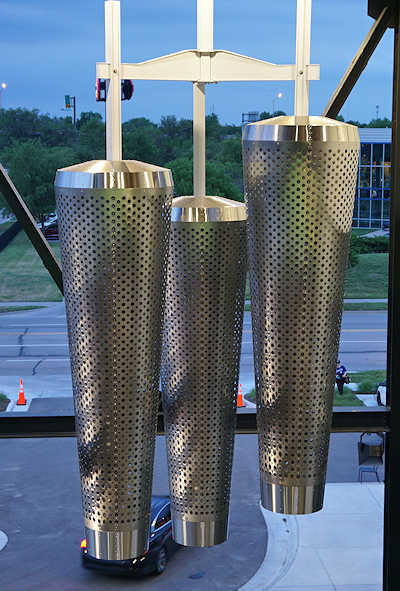 And it’s not just one kind of art that surrounds Riverfront Stadium’s exterior – it’s everything. Near the main entry gate that is part of the park’s right-field building – known as the River Plaza Entrance — is a 30-foot-tall cylinder entitled Faceted Column. Its 5,000 mirrored surfaces beckon to the downtown side of the river. Along the first-base exterior is a huge mural announcing to the world that this is Wichita Baseball (photo above). Take a good look along the bottom of the mural and you’ll see the names of the baseball teams that have played here, in chronological order.
And it’s not just one kind of art that surrounds Riverfront Stadium’s exterior – it’s everything. Near the main entry gate that is part of the park’s right-field building – known as the River Plaza Entrance — is a 30-foot-tall cylinder entitled Faceted Column. Its 5,000 mirrored surfaces beckon to the downtown side of the river. Along the first-base exterior is a huge mural announcing to the world that this is Wichita Baseball (photo above). Take a good look along the bottom of the mural and you’ll see the names of the baseball teams that have played here, in chronological order.
Hanging over your head as you pass through the first-base entryway (the team refers to it as the Maple Street Entrance) are three glittering pieces that resemble jet engines – turned vertical (see photo). You’ll note that a good amount of the art pieces references the area’s enormous aviation industry.
Perhaps my favorite piece of artwork might also be the most subtle, and you’re likely to miss it if you aren’t looking for it. Along the iron fencing that surrounds the west side of the park is a “mural” (for lack of a better term) of a pitcher throwing a ball and a batter swinging at it – and you can only see it from one angle. If you look at the fence straight on or coming from the opposite direction, you won’t see it at all. Once you’re standing in the right spot looking at the length of the fence, the clever image will pop out at you.
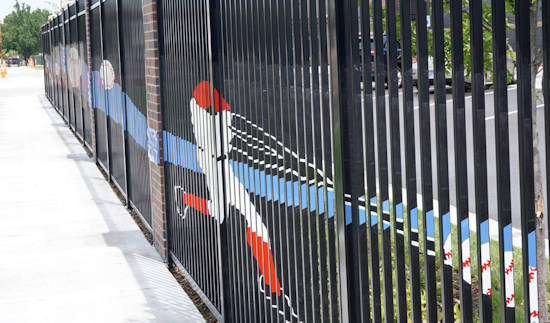
The northwest entry, referred to as the Delano Entrance since it’s so close to all of the development of the Delano District, is a veritable art gallery. Here you’ll experience an intentionally rusting abstract sculpture, to a series forms you have to get down on the ground to see through (photo below), to industrial-looking girders surrounding you as you walk into the ballpark.
 The artwork runs all through the ballpark’s interior as well.
The artwork runs all through the ballpark’s interior as well.
You’ll also notice that spots for future buildings – hotel, restaurant, retail – have been set aside in the park’s perimeter. And unlike most other sports facilities where development will happen one day, these spaces have already been leveled and grass is growing. They look nice. At other parks, these parcels are, at best, gravel lots.
The masonry used on the actual exterior of the ballpark takes its cue from the colors of the buildings in nearby Delano, as Bohm pointed out.
It should be pointed out that the look of the park and its immediate surroundings were heavily influenced by Schwechheimer. “Lou sent us hundreds of photos of places that he enjoyed,” Tingle recalls. “Amusement parks. Beaches. Baltimore’s Inner Harbor. He wanted us to be thinking about making this ballpark a place where people will enjoy themselves.” Based on all of these suggestions, the creative people at DLR Group created a huge drawing of what a festive ballpark for Wichita could look like (below) – complete with a Ferris Wheel between the stadium and the river.
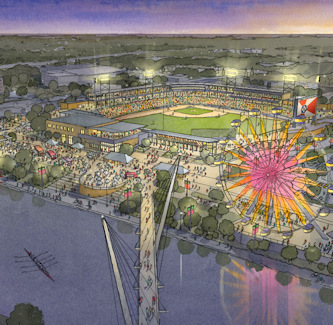 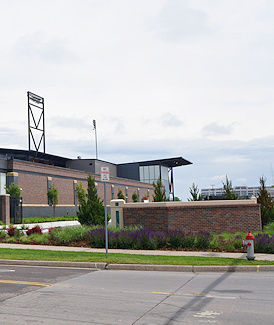 |
| Based on numerous emails from Lou Schwechheimer, DLR created the rendering above (courtesy of DLR Group). “It goes to show the idea of activating the river,” says Carlson. “(It’s) linking the west side of the river to downtown with a pedestrian bridge and the creation of a lively entertainment district on the river.” The photo above shows the exterior of the stadium, with plenty of spots where you’d put the name of the park — including a short wall right at the intersection of Sycamore and Maple that screams out to display the stadium’s name. When a corporate naming sponsor is signed on, it will. |
One thing I noticed in walking around the exterior is that there are several spots on the walls and one conspicuous, short piece of masonry directly behind home plate, where the name of the ballpark should appear. But it doesn’t. That’s because they are essentially placeholders for the corporate sponsor name that will one day be placed there.
Koch Brothers Ballpark?
Probably not.
So keep reading so we can examine the interior of Riverfront Stadium.